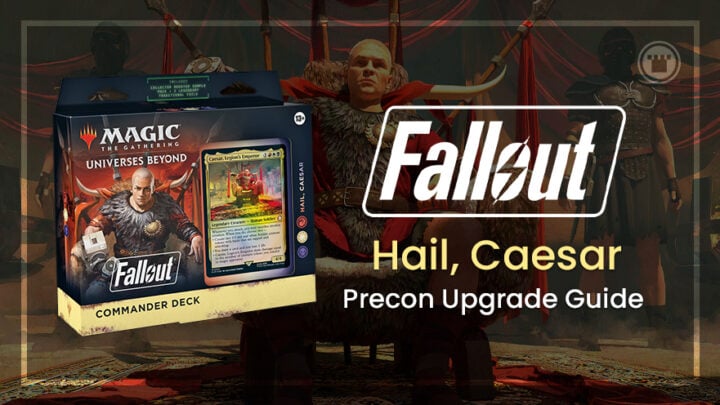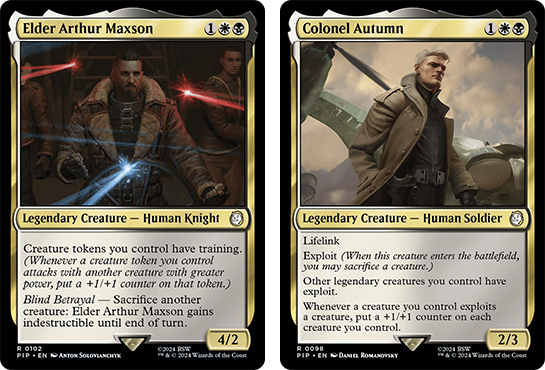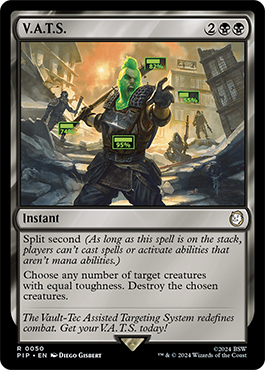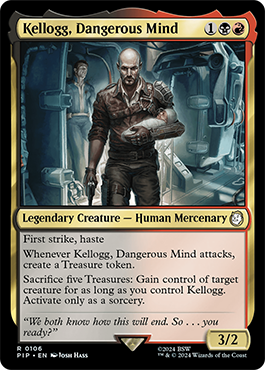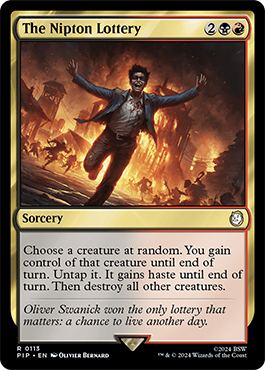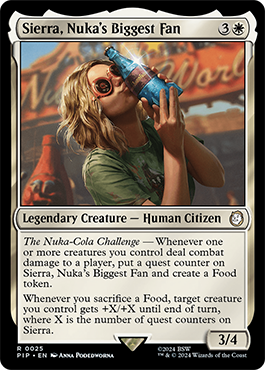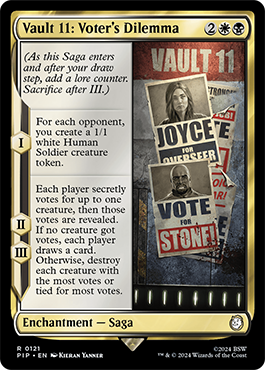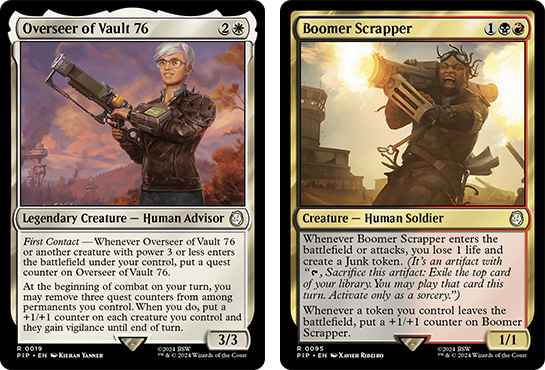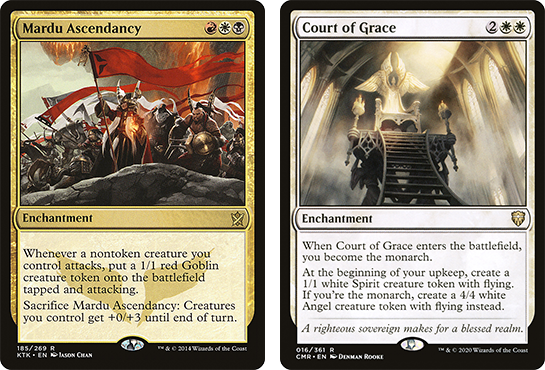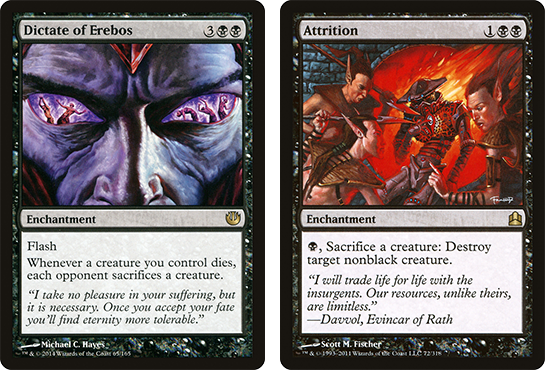The big design challenge for Universes Beyond: Fallout is how to adapt such a sprawling, storied franchise into just four Commander precons. Wizards seems to have based each deck on one of the Wasteland’s largest and most recognizable factions, and then added other characters and references from the games which share a similar ideology.
The Hail, Caesar precon deck is, as the name suggests, built around Caesar’s Legion from Fallout: New Vegas. Led by the self-proclaimed Son of Mars, their proud but brutal military culture has drawn in soldiers, gangers, tribesfolk and murderers from all corners of the Fallout timeline.
MEET THE COMMANDERS
The default commander choice for this deck is (of course) Caesar, Legion’s Emperor. This card is the perfect lynchpin for an aggressive, sacrifice-driven strategy, often referred to as an “aristocrats” deck.
As in New Vegas, the Legion’s ideal of total war requires a rank-and-file made up of expendable, indoctrinated troopers willing to die for the cause. Caesar and his hand-picked officers are your “aristocrats” in this case – using their abilities to buff your lesser troops, and then sacrificing them for bonuses whenever that becomes more useful.
Caesar’s own ability neatly combines all aspects of this gameplan: he can grow your army early on, draw extra cards once you have more efficient token generation online, and then provide a consistent win condition late. All he asks is that you keep growing your legion, and keep it on the offensive!
A big strength of Caesar’s design, and of this deck overall, is that his effect is powerful but not irreplaceable. Having Caesar in play really just lets you do more of what you’re already doing, and those effects are generic enough that you can pivot into a less aggressive gameplan without much effort.
One such gameplan is supported by this precon’s alternative commander: Mr. House, President and CEO. With the New Vegas mastermind at the helm, we retain our sacrifice themes but move away from the creature-heavy “aristocrats” playstyle to a more grinding, economic one.
As a gambling tycoon, Mr. House is all about treasures and dice. I just wrote an article on how to build a treasure-centric deck as one of the strongest possible Commander archetypes. Dice as a theme has a smaller card pool to draw from, but at least most of them work very well with Mr. House’s potential to throw tons of D6s per turn. There’s also no real need to expand the die-rolling theme beyond what’s already in the precon: House works fine as a flavorful treasure payoff and token generator without it.
PRECON REVIEW
As with previous Universes Beyond Commander precons, Hail, Caesar contains a huge swath of newly-printed cards to play in Commander, Legacy, Pauper and other Eternal formats. In fact, there’s way too many for me to give them all a serious analysis in today’s review. So while almost all these Fallout cards are interesting in one way or another, I’ll just focus on a couple which I think have the most potential to be used outside of this precon deck.
Paladin Elizabeth Taggerdy
Anyone who’s played against Kaalia of the Vast or Winota, Joiner of Forces should be aware how dangerous this ability is, especially on a reasonably cheap creature like Elizabeth. Putting creatures into play already attacking gives them a very good shot at dealing combat damage to a player, setting off some of the deadliest triggers in the game.
Elizabeth is also a way to bypass alternate casting costs and other similar restrictions on creatures which have them – and she even draws you a card. All you really need to do is pump her power and attack with two other creatures, which are easy conditions whether she’s your commander or part of the 99.
V.A.T.S.
This may look like a simple removal spell, perhaps even a touch over-costed for the current Commander environment. But the power of split second counts for a lot in an environment awash with defensive interaction. V.A.T.S. still can’t get around good old Swiftfoot Boots or Lightning Greaves, but it nullifies just about every other ace an opponent might be relying on to save their creatures: counterspells, Heroic Intervention, Mother of Runes, Deflecting Swat, Ephemerate, Teferi’s Protection, everything.
I’d rather pay a few extra mana to know for sure I’m breaking up my opponent’s combo than cheap out and find my spell fizzled, wouldn’t you? The fact it can headshot a bunch of extra targets you don’t like is just one more reason to say yes.
Kellogg, Dangerous Mind
Probably one of the stronger commander options in this deck if you don’t mind dropping white from the color identity, Kellogg is a perfect candidate to lead the kind of all-in treasure strategy I described last week. As a cheap hasty body which generates treasures on attack, he’s also a strong cog in the kind of “war economy” engine I wrote about the week before – which is very often a type of treasure deck itself.
How excited you are to use his activated ability probably changes from deck to deck, but at minimum it’s a strong situational option. Red-black may not always have the tools to keep Kellogg alive forever, but with enough sacrifice outlets your opponents will never get their stolen creatures back alive.
The Nipton Lottery
Four mana for a virtually unconditional boardwipe is where I start getting interested just on efficiency alone, and this one actually has an upside! Yes, I would consider the single random survivor to be 99% upside in this case.
If you’re playing enough creatures of your own, there’s a reasonable chance that you get to keep one of your own creatures to have a head-start in the race to rebuild. If you don’t, or you get unlucky and choose someone else’s creature, then you get to lay a free attack into your opponent of choice before (presumably) sacrificing the “survivor” anyway. I can’t think of many better ways to use 2RB.
Sierra, Nuka’s Biggest Fan
I once opined that Wizards never seriously used the design space around food tokens the way they did treasure or clues. But ever since Lord of the Rings: Tales of Middle-earth it feels like that’s completely changed, and dedicated food decks get another huge payoff here. The lovely Sierra isn’t just good with food synergies though; she can be used equally well just with a quest counter theme (which exists to some degree in this precon), or simply with proliferate.
She’s already strong when played fairly, especially in multiplayer where you might be able to add multiple quest counters per turn. But if you can stack the counters on her faster, or generate and sacrifice a lot of food quickly (you can always sac them to something that doesn’t cost mana) then she becomes a potential game winner.
Vault 11: Voter’s Dilemma
Even without extra synergies to exploit, I think this deal is generally very favorable: you get to make some free tokens and then destroy at minimum two of the most dangerous creatures on the board, ignoring shroud, hexproof, and even protection. In a lot of cases it will actually kill a lot more stuff than that.
The worst-case scenario is that some of that stuff is yours, but since you choose which deck to play this in and when to use it, it’s very manageable. Even the most spiteful opponents will rarely vote for your commander if it’s already indestructible and there are other threats present at the table!
Of course, if you have synergies that tie in with voting or sagas then this can get even better; Tom Bombadil in particular is all but immune to its “downside”…
$50 UPGRADE GUIDE
My first step when it comes to upgrading Commander precons is making sure we have a firm grasp of our gameplan, and what effects serve it. Then we can use that to identify the least valuable and synergistic cards from the stock list as potential cuts, and replace them with cost-effective upgrades that align better with the deck’s identity!
As I mentioned at the top of the review, Hail, Caesar enjoys a very well-defined gameplan: Caesar himself pretty much lays it out for us. I personally enjoy the “aristocrats” playstyle and so I’ll be sticking with this tokens-and-sacrifice theme with my upgrades.
But I think this precon is also a strong foundation for building with themes of treasures, legendary and historic spells, quest counters and proliferate, or self-mill. Some of those themes overlap heavily with the other Universes Beyond: Fallout precons, which seems very intentional. If you’re so inclined, one easy way to upgrade this deck is to buy some of the other precons and combine their best parts into one powerful, synergistic list!
Assuming we just have Hail Caesar to build on though, here are the first cuts I would recommend:
- Gary Clone
- Impassioned Orator
- Aradesh, the Founder
- ED-E, Lonesome Eyebot
- Mr. House, President and CEO
- Legate Lanius, Caesar’s Ace
- Thrill-Kill Disciple
- Heroic Reinforcements
- Entrapment Maneuver
- Fervent Charge
- Survivor’s Med Kit
- Luck Bobblehead
- Charisma Bobblehead
- Stolen Strategy
Most of these cards are not bad at all, but they either do things our deck has better ways of doing or aren’t doing the things we’re trying to focus on.
This deck wants to play quite a few high-cost spells to get our engine running and interact, while also requiring a steady stream of tokens to make the gameplan work. The easiest way to make that more consistent is to have a steady, free flow of tokens generated by enchantments or other sources, rather than relying on mana-intensive token generation like the Squad creatures.
The payoffs we have in terms of boosting combat damage are already quite powerful, so the other big upgrades I’m looking for are payoffs which give value when our tokens are created, attack, or die. Ideally we can find these attached to effects which provide at least a bit of extra utility, so we can use them to directly replace similar effects from the stock list. Let’s take a look at what affordable Commander staples we can find to fit those requirements.
I can’t think of a single card that offers more bang for buck in a deck like this than Commander Liara Portyr. She more or less casts both halves of Jeska’s Will, for free, every single turn. While we’re on attack triggers, we can include Isshin, Two Heavens as One as a way to double Caesar’s draw trigger, as well as many of the other cards in our deck! Most of our other good card draw options are very pricey, so we’ll slot in Liliana, Dreadhorde General and leave it there.
We already have some solid treasure generation, but Descent into Avernus is ideal in this kind of aggro deck, ensuring life totals become a real concern. To reduce our reliance on combat damage, we can also add Warleader’s Call, Court of Embereth (which also gives us a bit more card draw), Brutal Hordechief, and Impact Tremors.
Then we want to top off our automatic token generation with Goblin Assault, Court of Grace, Mardu Ascendancy, and the premium option: Bitterblossom.
Throw in a fun-of Gideon’s Sacrifice (it’s 5 cents and a pet card of mine) and we’re done! Here’s the full upgraded decklist on Moxfield for easy reference.
RENDER UNTO CAESAR…
With just these few changes we’ve hugely increased our consistency and resilience to board wipes, given ourselves more flexible win conditions, and more chances to draw them! I should also note that Bitterblossom, Warleader’s Call and Liliana make up the vast majority of that $50; you could make this a $20 upgrade package just by skipping those or replacing them with similar, cheaper cards.
This deck is also an extremely good home for effects like Grave Pact, Attrition and Dictate of Erebos – but besides the price tag, those may have an even greater social cost you should consider before adding them. As someone who already runs these kinds of cards though, I find the merciless and brutal nature of mutual sacrifice is the perfect flavor note to soup up Caesar’s Legion.
It also shows the potential for this deck to scale up to higher-power playgroups without losing its unique flair or even changing that many cards, which I really appreciate. Combined with an excellent commander and some very inventive new cards, the Hail, Caesar precon is just the kind of deck I love to see out of Universes Beyond, and any fan of Fallout: New Vegas – or Mardu decks – should pick it up.

Tom’s fate was sealed in 7th grade when his friend lent him a pile of commons to play Magic. He quickly picked up Boros and Orzhov decks in Ravnica block and has remained a staunch white magician ever since. A fan of all Constructed formats, he enjoys studying the history of the tournament meta. He specializes in midrange decks, especially Death & Taxes and Martyr Proc. One day, he swears he will win an MCQ with Evershrike. Ask him how at @AWanderingBard, or watch him stream Magic at twitch.tv/TheWanderingBard.

